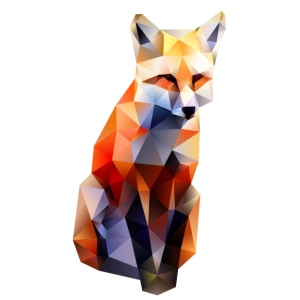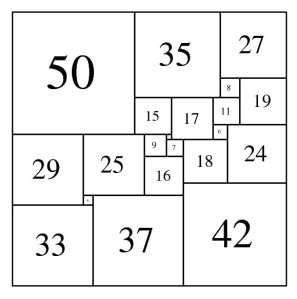Welcome to this week’s Math Munch!
How good are you at drawing circles? To find out, try this circle drawing challenge. There are adorable cat pictures for prizes!
What’s the best score you can get? And hey—what’s the worst score you can get? And how is your score determined? Well, no matter how long the path you draw is, using that length to make a circle would surround the most area. How close your shape gets to that maximum area determines your score.
Do you think this is a good way to measure how circular a shape is? Can you think of a different way?
This idea that a circle is the shape that has the biggest area for a fixed perimeter reminds me of the story of Dido and her famous problem. You can find a retelling of it at Mathematica Ludibunda, a charming website that’s home to all sorts of mathematical stories and puzzles. The whole site is written in the voice of Rapunzel, but there’s a team of authors behind it all. Dido’s story in particular was written by a girl named Christa.
If you have any trouble drawing circles in the applet, you might try using pencil and paper or a chalkboard. I bet if you practice your circling and get good at it, you might even be able to challenge this fellow:
Next up is squaring and the incredible Squaring.Net. The site is run by Stuart Anderson, who works at the Reserve Bank of Australia and lives in Sydney.
The site gathers together all of the research that’s been done about breaking up squares and rectangles into squares. It’s both a gallery and an encyclopedia. I love getting to look at the timelines of discovery—to see the progress that’s been made over time and how new things have been discovered even this year! Just within the last month or so, Stuart and Lorenz Milla used computers to show that there are 20566 simple perfect squared squares of order 30. Squaring.Net also has a wonderful links page that can connect you to more information about the history of squaring, as well as some of the delightful mathematical art that the subject has inspired.
 |
 |
 |
 Last up this week is triangulating. There are lots of ways to chop up a shape into triangles, and so I’ll focus on one particular way known as a Delaunay triangulation. To make one, scatter some points on the plane. Then connect them up into triangles so that each triangle fits snugly into a circle that contains none of the scattered points.
Last up this week is triangulating. There are lots of ways to chop up a shape into triangles, and so I’ll focus on one particular way known as a Delaunay triangulation. To make one, scatter some points on the plane. Then connect them up into triangles so that each triangle fits snugly into a circle that contains none of the scattered points.
Fun Fact #1: Delaunay triangulations are named for the Soviet mathematician Boris Delaunay. What else is named for him? A mountain! That’s because Boris was a world-class mountain climber.
Fun Fact #2: The idea of Delaunay triangulations has been rediscovered many times and is useful in fields as diverse as computer animation and engineering.
Here are two uses of Delaunay triangulations I’d like to share with you. The first comes from the work of Zachary Forest Johnson, a cartographer who shares his work at indiemaps.com. You can check out a Delaunay triangulation applet that he made and read some background about this Delaunay idea here. To see how Zach uses these triangulations in his map-making, you’ve gotta check out the sequence of images on this page. It’s incredible how just a scattering of local temperature measurements can be extended to one of those full-color national temperature maps. So cool!
Finally, take a look at these images that Jonathan Puckey created. Jonathan is a graphic artist who lives in Amsterdam and shares his work on his website. In 2008 he invented a graphical process that uses Delaunay triangulations and color averaging to create abstractions of images. You can see more of Jonathan’s Delaunay images here.
 |
 |
I hope you find something to enjoy in these circles, squares, and triangles. Bon appetit!




Pingback: ¿Qué tal se te da dibujar cicunferencias? | :: ZTFNews.org
Very fun! Reminds me a bit of the fun time I had trying to make a square of the 7 different triangle types http://mathhombre.blogspot.com/2010/12/triangle-puzzle.html and the lesson one of my students made out of the puzzle http://mathhombre.blogspot.com/2011/05/triangle-mosaic.html
Thanks for sharing, John.
Pingback: ¿Qué tal se te da dibujar cicunferencias?
Great post! I’m not sure about the algorithm on the draw a perfect circle site – though I love it – it seems that when you draw a bigger circle you get a higher percentage…
Also, I see Vi Hart has just made a video about trying to draw a circle:
Vi’s new video makes for a happy confluence of circle-drawing goodness. Thanks for sharing it!
I’ve also noticed that my scores tend to be higher when I draw bigger circles, but I think I’ve convinced myself that the difficulty isn’t with the scoring formula. I think the cause may be that small overlaps of circumference will cost more against you for smaller circles, since they’re more sensitive to small changes. Or maybe it’s just easier for me to draw circles well in the applet when they’re larger. If you have further thoughts, let us know!
Did you see math pickle’s lessons on squaring the rectangle? Some good puzzles that challenged my class:
http://www.mathpickle.com/K-12/MathPickle_Podcast/Entries/2010/9/22_Squaring_and_Subtracting.html
I’d like to know what the algorithm is. I wondered if it was counting pixels? That way the smaller ones would be much more course grained, than the bigger ones.
It would be interesting to see how other algorithms might compare. Variation in radius would make a good one, as Vi says in her video.
I do know Math Pickle! It’s not only a fantastic collection of problems, but I love the way Gordon talks about math and the world of math. The connections he draws between elementary mathematics and research mathematics are amazing and inspired.
Here’s a sheet I made inspired by the 45-45-90 triangle puzzles on Math Pickle, but with 30-60-90 triangles instead. Maybe your students would enjoy it, too!
Click to access 30-60-90%20partridge.pdf
I’m going to try to get in touch with Thomas Denney, who created the circle drawing challenge. Maybe we’ll get to do a Q&A with him. In any case, I’ll ask him about whether the discreteness of pixels is a factor in play. I suspect that the effect, if any, is too small to matter, but we’ll see.
Thanks so much for your comments, Simon!
Scale invariant. That’s the term that I was almost thinking of before.
Pingback: Math Teachers at Play #62 | Let's Play Math!
Oh, and I just noticed this great poster about ways of judging just how circular a freehand circle is – http://mei.org.uk/files/SeniorTMC2008poster-final2.pdf
Neat! Thanks for sharing. I’m thinking that the circle-judging method used in the challenge I posted is a better global measure of circularity, since the proposed methods in the link are only spot-checking circularity in a local way. That is, there are some real mosters of shapes that could get perfect-circle scores with some of the proposed tests.
I’m also excited to check into the organization that put out that challenge!
Finally, if one could “check in” to Math Munch by leaving a comment, you would now be Mayor of Math Munch! (Excepting Paul, Anna, and I, of course.)
Pingback: Solitons, Contours, and Thinking Sdrawkcab | Math Munch
Pingback: The Math Behind the Art :: Works by Jonathan Puckey | Minimo Graph
The video with the guy free-handing a perfect circle is really cool! How is he able to draw the circle so accurately and with such a quick motion?
It is impressing that someone can draw a perfect circle freehand but the video was boring.